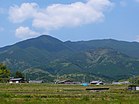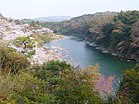Gojō, Nara
Gojō
五條市 | |||||||
|---|---|---|---|---|---|---|---|
| |||||||
 Location of Gojō in Nara Prefecture | |||||||
 | |||||||
| Coordinates: 34°21′23″N 135°41′44″E / 34.35639°N 135.69556°E | |||||||
| Country | Japan | ||||||
| Region | Kansai | ||||||
| Prefecture | Nara | ||||||
| Government | |||||||
| • Mayor | Kiyoshi Hiraoka | ||||||
| Area | |||||||
• Total | 292.02 km2 (112.75 sq mi) | ||||||
| Population (November 30, 2024) | |||||||
• Total | 26,998 | ||||||
| • Density | 92/km2 (240/sq mi) | ||||||
| Time zone | UTC+09:00 (JST) | ||||||
| City hall address | 1-1-1 Honmachi, Gojō-shi, Nara-ken 637-8501 | ||||||
| Climate | Cfa | ||||||
| Website | Template:Officia | ||||||
| Symbols | |||||||
| Flower | Chinese bellflower | ||||||
| Tree | Camphor Laurel | ||||||
Gojō (五條市, Gojō-shi) is a city located in Nara Prefecture, Japan. As of 30 November 2024[update], the city had an estimated population of 26,998 in 13363 households, and a population density of 92 persons per km2.[1] The total area of the city is 292.02 km2 (112.75 sq mi).
Geography
[edit]Located in western Nara Prefecture, the Yoshino River flows west through the city. It is surrounded mostly by mountains, although the city hall is located in a flat basin. Situated north of the city hall is Mount Kongō, at 1,125 meters. Persimmon is a major fruit crop in Gojō.[2]
Neighboring municipalities
[edit]Climate
[edit]Gojō has a humid subtropical climate (Köppen climate classification Cfa) with hot summers and cool to cold winters. Precipitation is significantly higher in summer than in winter, though on the whole lower than most parts of Honshū, and there is no significant snowfall. The average annual temperature in Gojō is 14.5 °C (58.1 °F). The average annual rainfall is 1,453.5 mm (57.22 in) with July as the wettest month. The temperatures are highest on average in August, at around 26.5 °C (79.7 °F), and lowest in January, at around 3.3 °C (37.9 °F).[3] The highest temperature ever recorded in Gojō was 37.8 °C (100.0 °F) on 5 August 2021; the coldest temperature ever recorded was −7.2 °C (19.0 °F) on 19 February 2012.[4]
| Climate data for Gojō (2006−2020 normals, extremes 2005−present) | |||||||||||||
|---|---|---|---|---|---|---|---|---|---|---|---|---|---|
| Month | Jan | Feb | Mar | Apr | May | Jun | Jul | Aug | Sep | Oct | Nov | Dec | Year |
| Record high °C (°F) | 17.8 (64.0) |
21.6 (70.9) |
24.6 (76.3) |
29.2 (84.6) |
32.6 (90.7) |
34.7 (94.5) |
37.3 (99.1) |
37.9 (100.2) |
35.4 (95.7) |
32.3 (90.1) |
25.4 (77.7) |
26.8 (80.2) |
37.9 (100.2) |
| Mean daily maximum °C (°F) | 8.3 (46.9) |
9.5 (49.1) |
13.8 (56.8) |
19.2 (66.6) |
24.5 (76.1) |
27.0 (80.6) |
30.6 (87.1) |
32.7 (90.9) |
28.1 (82.6) |
22.2 (72.0) |
16.2 (61.2) |
10.8 (51.4) |
20.2 (68.4) |
| Daily mean °C (°F) | 3.3 (37.9) |
4.2 (39.6) |
7.6 (45.7) |
12.5 (54.5) |
17.8 (64.0) |
21.5 (70.7) |
25.4 (77.7) |
26.5 (79.7) |
22.4 (72.3) |
16.6 (61.9) |
10.6 (51.1) |
5.6 (42.1) |
14.5 (58.1) |
| Mean daily minimum °C (°F) | −1.2 (29.8) |
−0.7 (30.7) |
1.6 (34.9) |
5.9 (42.6) |
11.3 (52.3) |
16.8 (62.2) |
21.3 (70.3) |
21.7 (71.1) |
17.9 (64.2) |
11.8 (53.2) |
5.5 (41.9) |
0.9 (33.6) |
9.4 (48.9) |
| Record low °C (°F) | −6.2 (20.8) |
−7.2 (19.0) |
−4.9 (23.2) |
−3.3 (26.1) |
0.9 (33.6) |
7.5 (45.5) |
15.2 (59.4) |
13.8 (56.8) |
9.4 (48.9) |
2.3 (36.1) |
−1.8 (28.8) |
−5.3 (22.5) |
−7.2 (19.0) |
| Average precipitation mm (inches) | 58.4 (2.30) |
79.2 (3.12) |
104.7 (4.12) |
96.5 (3.80) |
119.2 (4.69) |
177.7 (7.00) |
215.1 (8.47) |
126.2 (4.97) |
167.4 (6.59) |
171.6 (6.76) |
72.9 (2.87) |
64.6 (2.54) |
1,453.5 (57.22) |
| Average precipitation days (≥ 1.0 mm) | 7.9 | 8.5 | 10.3 | 10.3 | 9.0 | 11.9 | 12.8 | 9.1 | 10.5 | 10.3 | 7.9 | 8.9 | 117.4 |
| Mean monthly sunshine hours | 107.7 | 115.5 | 162.4 | 177.0 | 201.1 | 140.2 | 161.2 | 209.2 | 152.4 | 145.8 | 132.8 | 109.2 | 1,812.8 |
| Source: Japan Meteorological Agency[4][3] | |||||||||||||
Demographics
[edit]Per Japanese census data, the population of Gojō in 2020 is 27,927 people. The population has been on decline over the past quarter of a century.[5] Gojō has been conducting censuses since 1950.
| Year | Pop. | ±% |
|---|---|---|
| 1950 | 45,522 | — |
| 1955 | 49,416 | +8.6% |
| 1960 | 43,489 | −12.0% |
| 1965 | 42,122 | −3.1% |
| 1970 | 41,546 | −1.4% |
| 1975 | 40,892 | −1.6% |
| 1980 | 40,089 | −2.0% |
| 1985 | 39,600 | −1.2% |
| 1990 | 39,869 | +0.7% |
| 1995 | 40,871 | +2.5% |
| 2000 | 39,928 | −2.3% |
| 2005 | 37,375 | −6.4% |
| 2010 | 34,449 | −7.8% |
| 2015 | 30,997 | −10.0% |
| 2020 | 27,927 | −9.9% |
| Gojō population statistics[5] | ||
Demographics
[edit]Per Japanese census data, the population of Gojō is as shown below
| Year | Pop. | ±% |
|---|---|---|
| 1950 | 45,522 | — |
| 1960 | 43,489 | −4.5% |
| 1970 | 41,546 | −4.5% |
| 1980 | 40,089 | −3.5% |
| 1990 | 39,869 | −0.5% |
| 2000 | 39,928 | +0.1% |
| 2010 | 34,460 | −13.7% |
| 2020 | 27,927 | −19.0% |
History
[edit]The area of Gojō was part of ancient Yamato Province, and contains many kofun burial mounds and ancient Shinto shrine. During the Edo period, it was a castle town and part of the tenryō holdings under the direct control of the Tokugawa shogunate. During the Bakumatsu period, it was one of the sites of the Tenchūgumi incident. The town of Gojō was established on April 1, 1889 with the creation of the modern municipalities system. It was raised to city status on October 15, 1957 by merging with the town of Nohara and the villages of Makino, Kitauchi, Uchi, Sakaibe, Oata, and Minamiata. The village of Minamiuchi was annexed on January 1, 1957, and the villages of Nishiyoshino and Ōtō on September 25, 2005.
Government
[edit]Gojō has a mayor-council form of government with a directly elected mayor and a unicameral city council of 12 members. Gojō contributes one member to the Nara Prefectural Assembly. In terms of national politics, the city is part of the Nara 3rd district of the lower house of the Diet of Japan.
Economy
[edit]The local economy is based on agriculture, forestry and light manufacturing. In Sumikawa-cho in the northeast of the city, there are the industrial park Technopark, Naraya Gojo Wood Industrial Park, and the newly developed residential area Elbe Town Gojo and Renaissance Court, while the Gojo Kita Interchange on the Keihanawa Expressway and Iden-cho are home to the Kitauchi Industrial Park.
Education
[edit]Gojō has four public elementary schools, three public junior high school and one public high school operated by the city government and one public high school operated by the Nara Prefectural Board of Education. There are also a private junior high and a private high school.
Transportation
[edit]Railways
[edit]- T Kitauchi - Gojō - Yamato-Futami
Highways
[edit] Keinawa Expressway
Keinawa Expressway National Route 24
National Route 24 National Route 168
National Route 168 National Route 309
National Route 309 National Route 310
National Route 310 National Route 370
National Route 370
Local attractions
[edit]- Gojō Shinmachi old town
- Uchi River Rock Carvings, National Historic Site
Notable people from Gojō
[edit]- Ryotaro Tanose, politician
- Machiko Ono, actress
References
[edit]- ^ "Gojō City official statistics" (in Japanese). Japan.
- ^ 2005.Kangaeru Shakaika Chizu.Tokyo:Yotsuya-Ōtsuka Publishing, p.36
- ^ a b 気象庁 / 平年値(年・月ごとの値). JMA. Retrieved April 12, 2022.
- ^ a b 観測史上1~10位の値(年間を通じての値). JMA. Retrieved April 12, 2022.
- ^ a b Gojō population statistics
External links
[edit]- Gojō City official website (in Japanese)
 Geographic data related to Gojō, Nara at OpenStreetMap
Geographic data related to Gojō, Nara at OpenStreetMap










